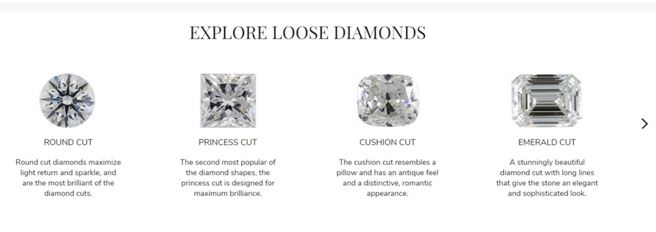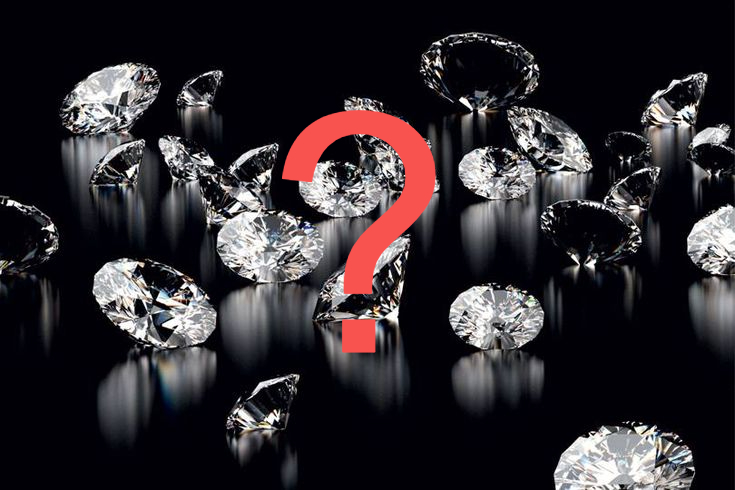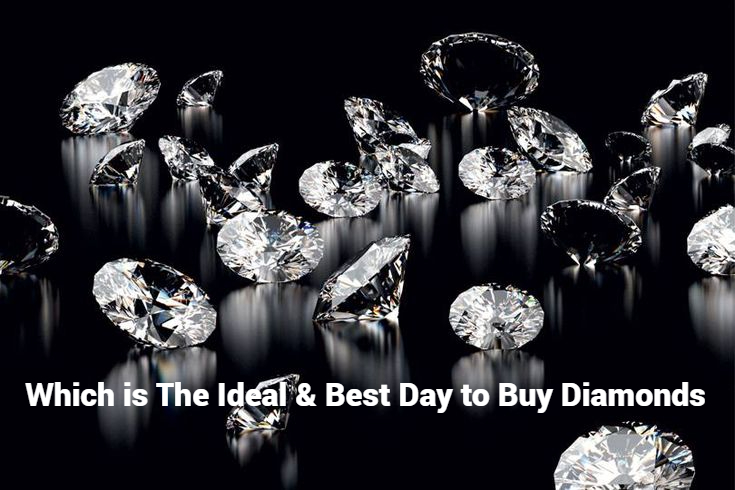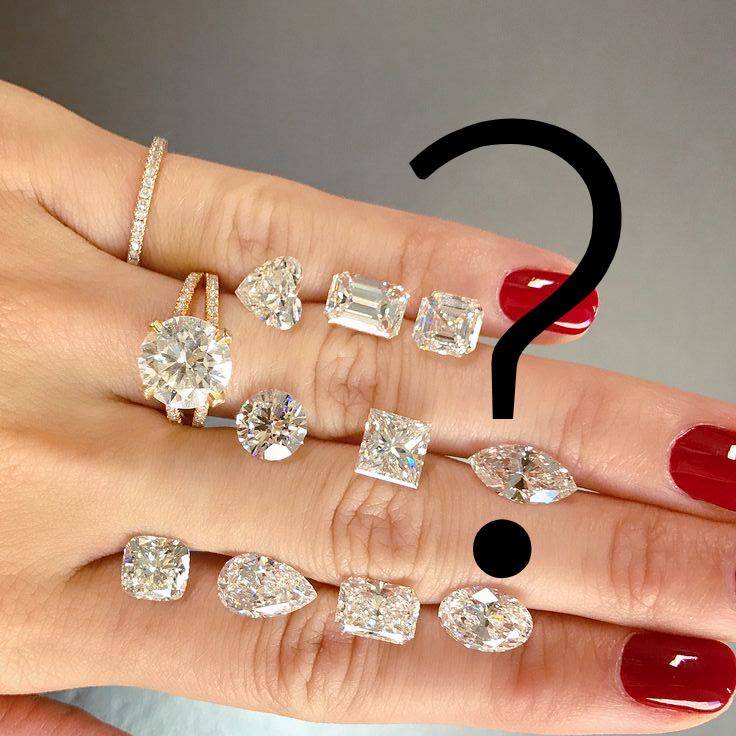One of the first things that strike you about the Asscher cut is the fact that it has a rich history, intertwined with royalty. As we would see, some of this has informed some modifications over the years. The Asscher cut has been around for a while and has evolved with time and demand for more elegance with a touch of royalty.
BRIEF HISTORY
As a cut with a rich history, the vintage feel that comes with wearing the Asscher cut makes it endearing.
First developed in 1902 by Abraham and Joseph Asscher, the stone was originally cut from a rough 3, 105 ct. Diamond. There were two, the Cullinan I and the Cullinan II. It is interesting to note that the Cullinan I is the diamond that decorates the Royal scepter in the British state jewels. It is pear-shaped and weighs 530.20 ct.
The second, the Cullinan II majestically decorates the British imperial crown, not surprisingly. It is cushion-shaped and weighs 317.4 ct.
The Asscher cuts have always been known for their class and elegance. Originally designed with 58 facets, they have a spectacular visual appeal and balance in scintillation that always makes them outstanding.
The peak of the Asscher cuts was at the Art Deco era in the 1920s. This era was known for bold geometric shapes and a vintage style arrangement. It was very popular in engagements in that era and was considered subtly aesthetic while preserving its antique and classy presentation.
Unfortunately, during this period, the Second World War stated. World War II negatively affected the Asscher Company and they had very serious problems with their diamond production afterward. The patent which they had on the production also ran out with the world war.
After the world war ended, they started to rebuild their company again, even though with great difficulty. After some years, they received a Royal title which greatly helped the production of the Asscher diamonds.
In 1999, Edward Asscher, (grandson of Joseph Asscher) decided to work on improving the Asscher cut. A lot of effort was put in to enhance the cut and then the Royal Asscher cut was produced. This cut boasted 16 more facets than the original Asscher cut. Of course, more facets translate to more reflection and better sparkle. He added two more rows, each bearing 8 facets to the bottom. Even with these additions, Edward was able to retain the classic and elegant look of the original Asscher cuts.
However, this time, the Royal Asscher cut to have an International Patent which allows only the Royal Asscher Company to cut a Royal Asscher diamond.
Today, the Asscher cuts and the Royal Asscher cuts are popular among people who value elegance but prefer a quieter aesthetic presence, with a blend of royalty.
It is seen in several engagement rings and some vintage jewellery stores.
Famous people who have won it include Elizabeth Taylor, Gwyneth Paltrow, and Jessica Alba, who wore it at different times for their engagements.
THE ASSCHER CUT
The cut of a diamond refers to its shape and how well it interacts with light. This cut is determined by several factors which include the polish, the symmetry and the proportion of different parts.
Asscher cut diamonds are known to use rough diamonds more efficiently than other types of cuts. Their weight is also more concentrated around the center than around the wide which is seen in the round cut. This means that the Asscher cut would appear smaller when compared to a round cut of the same size.
The Asscher cut is a step cut. It is a blend of the emerald and the princess cut. It is made up of X-shaped facets which extend to the center of the culet. The table of the Asscher cut diamond is flat, offering a clear and unobstructed view to the center of the culet. It has three rows at the top and three rows at the bottom. Each of the facets is large which helps in the brilliance of the stone. In the design of the Asscher stone, a lot of emphases is placed on clarity. The Asscher cut appears octagonal in shape and it has cropped edges, which all add to the elegance and style.
Some people refer to the Asscher cut as the “square emerald cut”. This is because, like the square, the Asscher cut has a Length to Width ratio of close to 1:1 as shown in the image below:
The Asscher cut also has a pointed culet which serves as a center of attraction to potential buyers.
The GIA has graded the cut into different classes which include:
- Excellent
- Very Good
- Good
- Fair
- Poor
Each of these grades has specific dimensions which must be met before a cut is classified as one.
ASSCHER DIAMOND CUT QUALITY
| DIAMOND PART/CHARACTERISTIC | ||||||
|
CUT GRADE |
TABLE (%) |
DEPTH (%) |
PAVILLION DEPTH (%) |
GIRDLE |
CULET |
LENGTH TO WIDTH RATIO |
|
EXCELLENT |
<69 |
61 – 68 |
42 – 43
|
Very thin to Slightly thick |
None |
1.0 – 1.05 |
|
VERY GOOD |
70 – 72 |
59.0 – 60.9 or 67.1 – 70.0 |
41 – 41.9 or 43.1 – 43.9 |
Very Small |
||
|
GOOD |
73 -74 |
57.0 – 58.9 or 70.1 – 74.0 |
40 – 40.9 or 44 – 44.9
|
Thin to Thick |
Small |
1.06 – 1.08 |
|
FAIR |
75 – 79 |
54.0 – 56.9 or 74.1 – 79.0 |
39 -39.9 or 45 – 45.9 |
Very thin to Very Thick |
Medium |
|
|
POOR |
80 and above |
<54.0 or >79.0 |
< 39 or > 46 |
Extremely Thin to Extremely Thick |
> Medium |
>1.08 |
It is important to know that depth is always better when it is lower. This is because a more shallow diamond would look larger. The Asscher cut also allows you to experiment more with the depth, because it does not need depth for brilliance, unlike the Round cut in which depth is a very important characteristic for sparkle.
However, the range of 61 – 68% is recommended as shown in the chart.
In selecting an Asscher cut diamond, it is expedient that attention is paid to the culet at the center. There is a characteristic ‘windmill’ pattern which is seen looking from the table. This pattern distinguishes the Asscher cut and is formed by the meeting of all the facets at the center. If the cut grade is low, the windmill appearance might be distorted and show large dark areas. This kind of cuts should be avoided as they do not provide real value for your money
ASSCHER DIAMOND CLARITY
Based on the build of the Asscher diamond, the diamond would show more inclusions than a round cut. This is because the table provides a clear and unobstructed view. The step-cut does not also reflect light so much which would have covered the inclusions.
In other words, the type of symmetry seen in round cuts with their facets reflecting and breaking up light is absent in the Asscher cut. This makes inclusions much more visible. The implication of this is that when going for an Asscher cut diamond, the clarity is a major factor to consider; the Asscher cut was not designed for brilliance, its beauty lies in being clean and sharp when light passes through it.
Based on this widely accepted GIA clarity scale, the recommended clarity scale should include the Very Slightly Included, the Very Very Slightly Included, the Internally Flawless and the Flawless. It is recommended that lower grades of clarity should be avoided. This is because inclusion in a round cut diamond of an SI1 or SI2 for instance, would not be easily visible to the naked eye. However, in an Asscher cut, the inclusion would be clearly visible.
That said, there might be some SI1 grades which have inclusions at the side, just underneath the step facets.
Whichever you decide to go for, contact a gemmologist for advice, especially when going for a grade lower than the VS2.
As the size increases, the grade that is recommended also changes because the extent to which inclusions can be accommodated without being visible also increases.
Any choice made is dependent on you. The degree of inclusions preferred is not the same for everyone. Some might like their gems entirely clean and flawless, while some do not mind if there are inclusions. All of these should be taken into consideration when choosing a diamond.
RECOMMENDED DIAMOND CLARITY RANGES
| DIAMOND GRADE | |||||
| WEIGHT(Ct) | EXCELLENT | VERY GOOD | GOOD | FAIR | POOR |
| <0.50 | FL –VS2 | SI1 | SI2 | I1 | >I1 |
| 0.51 – 1.00 | FL –VS1 | VS2 | SI1 | SI2 | > SI2 |
| 1.00 – 2.00 | FL – VVS2 | VS1 – VS2 | SI1 | SI2 | > SI2 |
| > 2.00 | FL –VVS2 | VS1 | VS2 | SI1 | > SI1 |
ASSCHER DIAMOND COLOR
When it comes to the color with the Asscher cut, more caution would also need to be taken. The reason for this is also not farfetched: there are fewer facets, which help to mask the coloring present.
This means that a small amount of coloring normally masked in round cuts and other brilliant cuts would be more obvious in the Asscher.
Based on this GIA grading system, it is advisable to pick a color grade of I or better. As we have discussed, the coloring would be more obvious in lower grades.
However, there might be some J Asscher cuts with less visible coloring, which could be considered. But it is always advisable to consult a gemologist in such instances.
RECOMMENDED COLOUR RANGE
| DIAMOND GRADE | |||||
| WEIGHT (ct) | EXCELLENT | VERY GOOD | GOOD | FAIR | POOR |
| < 0.50 | D – G | H – I | J – K | L -M | > M |
| 0.51 – 1.00 | D – F | G | H – I | J – K | > K |
| 1.00 – 2.00 | D – F | G | H- I | > I | |
| > 2.00 | D – F | G | H- I | > I | |
CARAT
As with all other cuts, there are expected weights for each size of the diamond. The size of the diamond refers to the diameter and it increases as the carat weight increases.
It is also important to note that the shape of the Asscher does not diminish, even when smaller, it just becomes more compact. The expected weights and sizes of the Asscher are as follows:
| Weight (ct) | Size (mm) |
| 0.39 | 4.00 |
| 0.50 | 4.50 |
| 0.75 | 5.00 |
| 1.00 | 5.50 |
| 1.25 | 6.00 |
| 1.50 | 6.50 |
| 2.00 | 7.00 |
| 2.50 | 7.50 |
| 3.00 | 8.00 |
| 3.50 | 8.50 |
| 4.10 | 9.00 |
| 5.10 | 9.50 |
| 5.60 | 10.00 |
After going through all the tables and charts are given, you should know that buying an Asscher cut diamond goes beyond reading tables and chats. Even the GIA rating for polish and symmetry might not be entirely adequate to judge the light performance of an Asscher diamond. Therefore, as a potential buyer, seek for photographs and videos that clearly show the light performance of the diamond that you want to purchase.
DIFFERENCES BETWEEN THE ASSCHER AND THE EMERALD CUT
Since these two cuts are very similar in shape, may people sometimes confuse them, while others do not even know they are different.
But, there are some subtle differences between the two which include:
- Shape: This is the primary difference. The emerald cut is rectangular in shape with straight corners. The Asscher cut is a square version of the emerald, with truncated edges. This is why it is also referred to as the ‘square emerald cut’
- Culet: the emerald cut has a flat long culet while the Asscher cut has a pointed culet which is representative of where the facets converge.
- Size: due to the arrangement of the facets, the emerald cut is generally larger in appearance than the Asscher cut.
ADVANTAGES FOR THE ASSCHER CUT
- PRICING: The Asscher cut diamonds are cheaper than their corresponding round cuts. As we said earlier, the Asscher cut uses more rough diamond efficiently and so less is wasted during the cutting process. Also, due to the fact that it looks smaller than a similar round cut of the same sizes (due to the concentration of weight around its center).
- ANTIQUITY: If you are someone that places value on antiquity, then you might want to go for the Asscher cut. It has a rich heritage and even though has been around for a while, it still preserves its elegant look.
- SETTING: the Asscher cut can easily be combined with other gemstones of supreme quality, even those with higher hardness ratings like rubies and still produce a stunning appearance. It easily sets into its surroundings.
- DURABILITY: Unlike the round cut with corners that can easily be damaged, the Asscher cut has truncated corners, therefore, reducing the risk of getting damaged easily. This means that it can be worn without having to worry about an edge being damaged while going about your business. It is built to last.
- EXCLUSIVITY: Only the Royal Asscher Company is licensed to cut an Asscher stone. This means not everyone is doing it and your diamond would always stand out as the select few. Remember that it also has very strong ties with royalty.
DISADVANTAGES FOR THE ASSCHER CUT
- IT LACKS BRILLIANCE: The Asscher cut lacks brilliance. As it is a step cut, the facets are not arranged in such a way as to reflect light back to the eye and as such, this cut would not produce good fire or sparkle or scintillation as its corresponding round cut diamond.
- FLAWS ARE VERY EASILY SEEN: Remember we pointed out that the Asscher cut was designed to showcase clarity and sharpness of a diamond. However, we also know that very few diamonds have no inclusions or flaws of any kinds. Most diamonds would have some form of inclusion and when they are cut into Asscher stones, these inclusions easily show. They are not good at also masking color. An inclusion which would not be seen in a round-cut, due to the dispersion of light by the facets, (which help to hide the flaw) would be very visible in an Asscher cut.
- MORE EXPENSIVE THAN OTHER FANCY CUTS: Among the fancy cuts, it is more expensive because of the obvious fact that it requires a great deal of craftsmanship since inclusions and flaws are easily seen. It would also require an exceptional stone to be able to create a truly spectacular Asscher cut.
- IT LOOKS SMALLER IN SIZE: Due to the distribution of the weight around the core majorly, the size of the diamond when viewed looks smaller for its particular weight. This might reduce the visual appeal of the diamond and customers might not feel like they are getting value for their money, especially when they can get other cuts which would look bigger for about the same price.
In conclusion:
we have seen that the Asscher cut has a lot of peculiarities regarding its history, design, and features. As a buyer, all of the charts and percentages are shown are just to guide you to make the best decision. There would be some subjective considerations based on what you want in the Asscher diamond and what you want to use it for. Some buyers might not mind an inclusion that is visible or obvious coloring in their gemstone, for instance.
Therefore pick what suits you best and always contact your gemmologist when not very clear.



